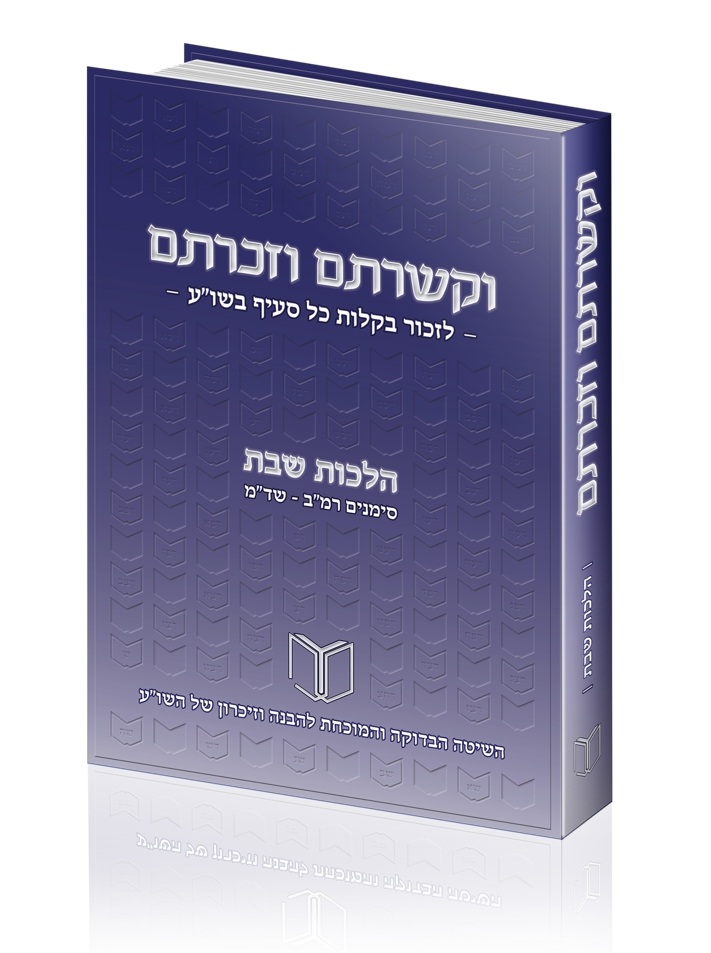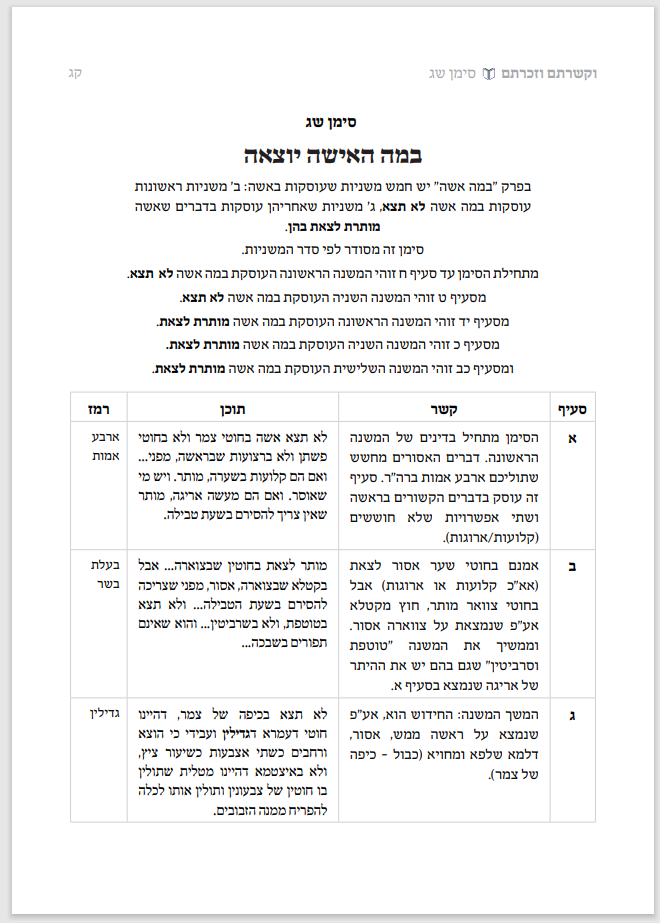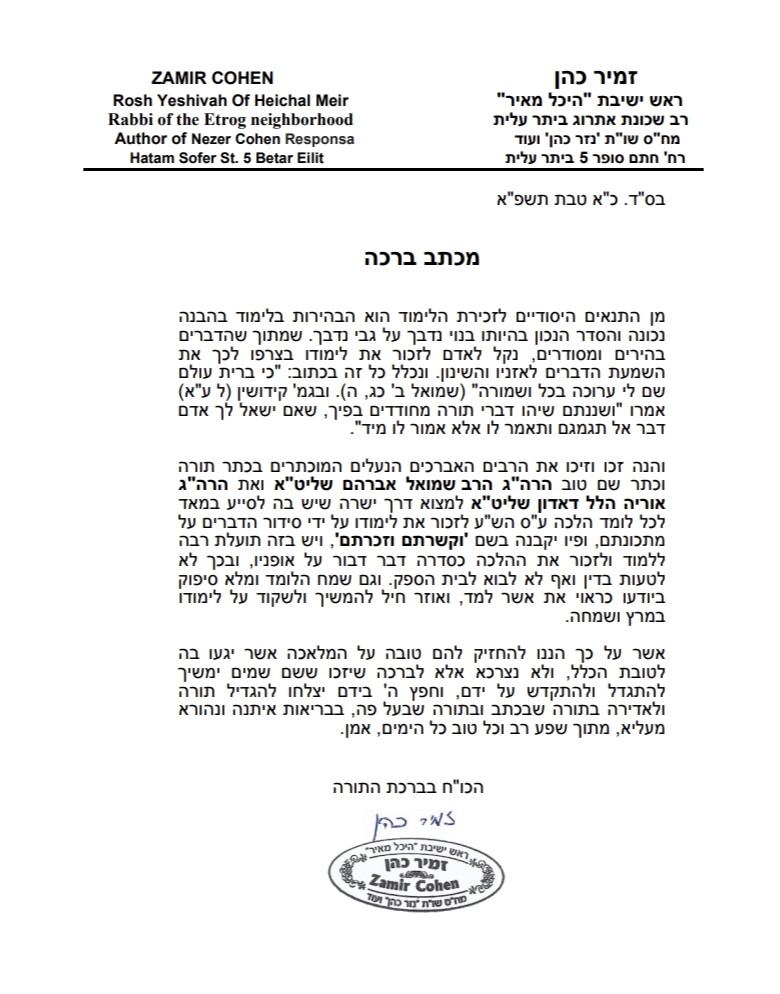The Two Scholars Who Unlocked the Learning Secret of the Shulchan Aruch: "Most People Think It's a Random Collection of Laws"
Despite their dedication, they found themselves quickly forgetting the Shulchan Aruch's material. Through the "And You Shall Bind Them and Remember Them" method, they discovered how to retain the knowledge for years.
 Uriah Hillel Dadon on the right, Shmuel Avraham on the left
Uriah Hillel Dadon on the right, Shmuel Avraham on the leftRabbis Shmuel Avraham and Uriah Hillel Dadon, both only 34, have already passed the rabbinical certification exams on the laws of the Shulchan Aruch. Despite excelling in the exams, they were astonished to find that the material soon faded from memory. After developing a unique study method encouraging long-term retention, they published several booklets, distributed for free, detailing how to learn and remember these laws. Currently, they are releasing the book "And You Shall Bind Them and Remember Them - The Complete Guide to Easily Remember the Laws of Shabbat and More". But let's not get ahead of ourselves.
Going back to those days, the 'downturn,' as Rabbi Avraham describes it, came shortly after successfully completing their exams. "One day, while waiting for my study partner on a bench in the kollel," he recalls, "I casually opened the volume of Shulchan Aruch on the laws of Niddah, which I had been thoroughly tested on, and was surprised to find that despite the short time since studying, the signs and sections seemed foreign and distant from my memory.
"Going over the numerous laws, it was hard to believe I had studied them so thoroughly not long ago. I was even embarrassed with myself. Clearly, during the study and exam period, I had full command of the material, forwards and backwards. My proficiency was perfect, and yet, in such a short time, everything vanished. It was a painful feeling, but more than anything, I was troubled by the sense that my life's dream was fading. I had always aimed to eventually hold the authority of teaching in Israel. But how could one teach when they can't remember the laws and rulings, studying them as if for the first time?! I wondered," describes Rabbi Avraham of his feelings in the face of the forgetfulness.

The full descent into harsh reality was experienced by Rabbi Avraham the next day when he tried sharing his feelings with his study partner. He discovered that his partner, who had also passed the exams, faced a similar situation. Upon delving deeper into the phenomenon, Rabbi Avraham noticed that the problem arises when moving on to studying different topics. "It reached a point where even material that had been 'set in the box' was pushed to the recesses of the mind and nearly forgotten due to the transition to different and new study material. We couldn't accept this and knew we had to find a solution.
At this stage, Rabbi Avraham and Rabbi Dadon invested significant time in reviewing and reiterating previously learned material, even while occupied with other subjects. "We devised structured review plans, allowing us to revisit all the laws of Niddah we've learned and been tested on, while continuing our prior studies on the laws of Shabbat," says Rabbi Avraham. "There's no denying, it was a fruitful and fulfilling task. Yet the disappointing reality set in again. It seemed as if nothing changed. Despite the thorough review, we still struggled to properly remember the many and detailed laws. It was clear we needed to find some golden key to make our learning permanently enduring.
How to Learn and Remember Long-Term?
It was the intense engagement with the Shulchan Aruch and its commentaries, driven by constant repetition, that highlighted certain points for the two that they hadn't noticed before. They explain that the sections and structure of the chapters aren't random but are wisely planned to facilitate memorable learning for the long term. "In this remarkable journey, we slowly discovered that the writing style of the Tur and the Shulchan Aruch, aimed to establish the laws in each subject, is a special phenomenon in its own right. We noticed there's a hidden amazing structure by which the laws are organized, sign by sign and section by section. We realized that if we grasp the secret chronology of the arrangement, topics, and sub-topics, we might then succeed in remembering the numerous laws, which would no longer be a random assortment but rather a coherent chain where each section is linked to its predecessor, and thus follows logically.
 Full Study Guide
Full Study GuideSo How Does It Work?
"After three years of work, we concluded there's a specific order to the signs of the Shulchan Aruch, such that if we take, for example, the laws of Shabbat, each sign has its precise place and couldn’t occur elsewhere. This understanding leads to a clearer comprehension, helping individuals remember the laws since they understand there's a specific order. Not only that, every section within a sign has its exact place, meaning if a sign comprises 20 sections, each has its own place and reason.
"For example," they continue, "we have sign 253 and sign 254; the first discusses cooking, and the second focuses on roasting and baking. One might question why the laws of cooking, baking, and roasting need division into two parts? The answer lies in the differing laws, leading them to be split into separate signs, easing the experience for learners. Indeed, certain topics seemingly belonging to one sign might appear in another because their specific legal treatment differs from similar categories, warranting their placement elsewhere despite subject differences within the sign.
 Screenshot from the book
Screenshot from the bookThe two realized that only in this way would they achieve their goal and recall the laws clearly and orderly, and chiefly, finally, for the long term. "It completely captured us. For three years, we diligently worked through all the laws of Shabbat and the prohibitions and authorizations. We discovered a new world. The entire content was remarkably organized in our minds and memories. Beyond the immense satisfaction it brought us, we found ourselves with a summary of the material that evolved into a monumental Torah creation on all the laws of Shabbat and prohibition and authorization in a renewed light. A summary presenting the new method perfectly."
Now, having achieved their aim, Shmuel and his friend faced a significant hurdle. "Naturally, we approached our fellow students at the kollel bench to share with them this discovery and great news, supposed to help anyone seeking clarity, understanding, and memory in all parts of the Shulchan Aruch.
Presumably, the response was enthusiastic.
"Not at all. Quite the contrary, there was marked skepticism. Naturally, it was hard for people to believe a magic formula had been found, overlooked until today. It must be appreciated that we don’t claim to have invented something new; we’ve merely pointed out a wonderful, renewed aspect within the parts of the Shulchan Aruch and the Tur. We believe this is the proper way of study, though the concept hadn’t been formally recognized," they explain.
"In any case, many found it hard to agree with the new method. We faced challenging moments of difficulty and doubt. Since even our close friends, from whom we expected enthusiastic feedback, reacted with disbelief, we started questioning ourselves and experienced insecurities about the method we developed".
Rabbi Avraham and Rabbi Dadon found themselves in a state of helplessness with the fresh concept forced into seclusion as they sought to chart a new course. This lasted a few months. "After several months, we began hearing differing voices. Those friends who were impressed by the method returned and asked why we hadn't published the material and shared the exceptional discovery with more people. In hindsight, those encouragements empowered us to believe in ourselves and take the significant step of publishing the material.
"Before publicly releasing the material, we wanted to further solidify the method and decided to apply it to the laws of Niddah, prayer, and blessings. When we presented the material, covering several subjects in the Shulchan Aruch, to prominent rabbis, including Rabbi Zamir Cohen, head of our institutions; Rabbi Yitzhak Yosef, and Rabbi Amar; along with Rabbi Yoram Sari, a rabbi in Modiin Illit, to seek their approval, the material was greeted with enthusiastic commendations. The sages recognized the truth of the method and wrote warm recommendations for it."
Giving Thanks for Completion
From here, the path was straightforward. The authors responded to many requests, beginning to distribute their work in organized booklets by subject matter in the Shulchan Aruch; laws of Shabbat, laws of prohibition and authorization, and more. "We published the booklets and distributed them freely. Additionally, we produced dozens of short, accessible videos illustrating how to apply the method to different signs in the Shulchan Aruch. Today, we know of at least three thousand scholars using the 'And You Shall Bind Them and Remember Them' technique."
"Even non-religious individuals I spoke with grasped the method's secret. Beforehand, they believed the parts of the Shulchan Aruch to be the most complex thing in the world, but the concept resonated with them too. Our principle of 'templates,' the rules, and details underpinning the Shulchan Aruch, is a principle also studied in high school for different subjects.
The book currently being released is titled 'The Complete Guide – Easily Remember Any Section,' initially covering the laws of Shabbat and prohibition and authorization. Looking ahead, the two plan to release another book covering the remaining portions of the Shulchan Aruch. The new book aims to impart law students the knowledge and tools to easily recall their studies, experiencing joy and satisfaction each time anew.
 Rabbi Zamir Cohen's approval for the book
Rabbi Zamir Cohen's approval for the bookRabbi Avraham currently conveys the core principles of the method in lectures at kollelim and educational institutions under the title 'The Four Steps – Easily Remember Any Section in the Shulchan Aruch.' "During the lecture, I explain the writing and editing style of the Shulchan Aruch, providing practical tools for remembering each section. Today, those lectures are in high demand. Recently, I heard from several scholars who successfully passed rabbinical exams thanks to the method that helped them recall the answers smoothly and accurately. On this drive, we need no more to stay energized and continue spreading the idea."
What prominent questions do you encounter from those exposed to the method?
"Many want to ensure the method assists everyone. They ask if the method will work for them. I explain to everyone it suits each individual. Just as everyone knows how to count from one to a hundred, this method is equally simple.
Even those seeking a straightforward 'tip' for applying the method receive guidance. "I recommend the approach used by the Talmud, which questions each statement 'Pshita' or 'What does this teach?' Similarly, in studying the Shulchan Aruch, for each section, inquire about the novelty in it and its source, and understand why it is placed where it is and wasn’t mentioned earlier or later in the order of sections," says Rabbi Avraham, adding, "To sum up: whoever consistently studies this way is certainly assured of finding satisfaction in learning and will solve the universal forgetfulness problem we also grappled with at the beginning of the journey. With the help of Hashem, we've been blessed to offer this great concept to the public, and we hope to continue progressing in this field."
Booklets and the book can be obtained from the authors - 0527142127

